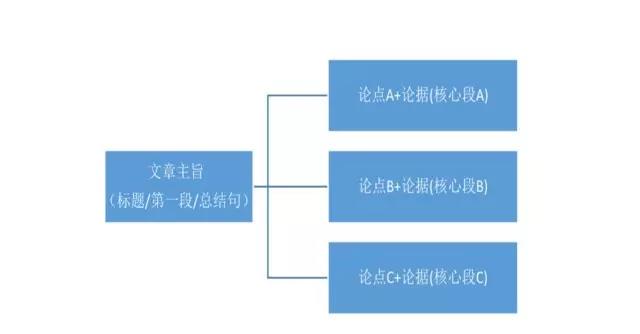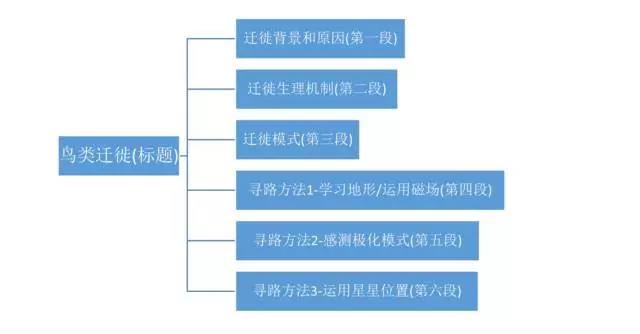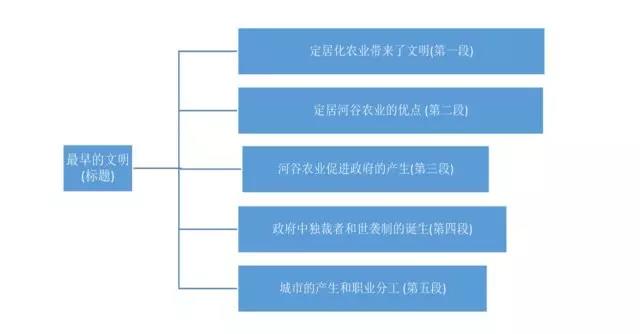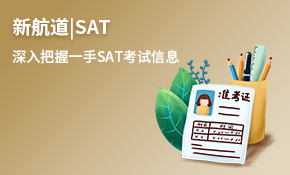如何急速突破托福阅读压轴题?
我在托福阅读的教学生涯中,经常听到刚接触托福阅读的考生们发出这样的感慨:“托福阅读的最后一个题型该怎么做啊?!花了很长的时间选了三个选项, 最终还是选错了一个。”托福阅读的最后一个题型:文章总结题 (summary),作为每次考试的压轴题型,让很多考生头疼不已,甚至有很多同学最后在考试时间 所剩无几的情况下,直接凭直觉进行选择。在接下来的文章里面,我们就来了解一下一种闪电般突破托福文章总结题的方法。

首先,我们来看一下文章总结题的题干内容:
An introductory sentence for a brief summary of the passage is provided below. Complete the summary by selecting the THREE answer choices that express the most important ideas in the passage. Some sentences do not belong in the summary because they express ideas that are not presented in the passage or are minor ideas in the passage. This question is worth 2 points.
题干中的每一句话都是字字珠玑,都值得细细品味,给我们指明了解题的道路。
题目给出了一个总结性的句子 ( 下面我们直接称为总结句 ) 作为对全文的摘要, 我们要从六个选项中选出的三个选项,即是最重要的信息。
错误的三个选项有可能是原文中未提及的内容,也有可能是次要信息。这也就意味着:部分选项的内容摘自于原文,和原文信息是一致的,但是它表达的不是最重要的内容,因此不 能选。显而易见,如何判断什么是重要信息,什么是次要信息成为了解题的关键。
此时,我们换一个思维,从写作的角度来考虑,问题就会显得简单了很多。
往往, 我们在写英文作文的时候,文章的标题反映了全文最核心的内容,段一般是背景介绍或者是话题导入,会亮出自己的主要观点。随后,从第二段开始就核心观点进行论证,在论证的过程中,采用的是论点句加上各种各样的论据的方法。 我们可以将这个逻辑抽象为下图:

因此,我们选出来的三个选项应该是组成了文章主旨的论点 A、论点 B、论点 C。我们只需要花最少的时间把这三个分论点找出来即可,而无需花时间来理解文章中的其他内容。
我认为在快速寻找分论点的过程中,有两点极为重要:
点是可以通过总结句,来帮助我们梳理全文的脉络;
第二点是在段落中,快速理解‘首二末’三句话,概括出段落主旨。

解析总结句
文章的主旨体现在文章的标题:段和给出的总结句中。
因此,解题的个步骤就是阅读文章标题和总结句,把握主旨和我们下面寻找内容的大方向。根据文章类型的不同,我们会发现给出的总结句也有不同的风格。
1 总结句核心为方法、原理、原则等名词,则原文一般为并列型陈述方法。
比如,在 Bird Migration 一文中,给出的总结句为 Scientists have proposed several methods that birds use for orienting themselves during their seasonal migrations. 句 子的宾语为 several methods,本文论述的核心为鸟类迁徙的方法。
此时,我们选出的三个选项 应该为几个方法,而无关其他内容,文章的结构如下

所以,我们选出来的三个答案为文章的四、五、六这三个段落的主旨内容,错误的选项中则 出现了概括第二段和第三段的选项,作为迷惑选项,对学生具有较强的杀伤力。
再比如 Caffeine Extraction Methods 一文中,summary 给出的总结句为 Methods for making a flavorful coffee without caffeine have been developed. 主语为 methods, 标题 也为 methods, 所以我们非常明确自己的寻找对象。

对文章稍作分析,就会发现全文为并列式论述,将各个方法并列陈述,最终的答案只需要 选这几个方法即可。错误的选项中包括了剥离咖啡因的原因,某些方法的缺点,这些内容和二、 五、六、七段的方法相比就不那么重要了。

2 总结句体现了某一类事物的重要性,则原文一般为按时间顺序或因果等逻辑顺序进行论证。
比 如, 在 The first civilizations 一 文 中, 总 结 句 为 The practice of settled agriculture in some areas of Asia and Africa was crucial to the development of early civilizations. 强调了 settled agriculture 对于人类文明的重要性。

很明显,文章是按照时间顺序进行逻辑论证,从在河谷边定居,到政府的产生,再到独裁者 和世袭制的诞生,最后产生了城市和越来越多的职业。最终选择出来的三个分论点则对应原文的第二段、第三段和第五段的主旨内容。
在这类文章 中,阅读后,快速把握住文章论证的逻辑,是解题的关键。
解析段落首二末
在核心段落中,分论点一般会出现在段落的第 一句话、第二句话、或者是最后一句话,也就是所 谓的‘首二末’三句话才是我们应该去直接阅读的内容。
当然,在实际的阅读过程中,我们要通过自 己敏捷的思考,快速找出首二末这三句话中最能代 表段落主旨的一句话并进行归纳概括。
1 以 He Development of Steam Power 一文举个例子,我们择出文中第二段:
As this early energy crisis grew worse, Britain looked toward its abundant and widely scattered reserves of coal as an alternative to its vanishing wood. Coal was first used in Britain in the late Middle Ages as a source of heat. By 1640 most homes in London were heated with it, and it also provided heat for making beer, glass, soap, and other products. Coal was not used, however, to produce mechanical energy or to power machinery. It was there that coal's potential wad enormous.
句话交待的很清楚,英国期待使用 coal 作 为 wood 的替代物。直接再看最后一句话,coal 的潜 力很大。因此,第二段的核心主旨即可概括为 coal 可以取代 wood。

2 再看该文的第三段
As more coal was produced, mines were dug deeper and deeper and were constantly filling with water. Mechanical pumps, usually powered by hundreds of horses waling in circles at the surface, had to be installed. Such power was expensive and bothersome. In an attempt to overcome these disadvantages, Thomas Savery in 1698 and Thomas Newcomen in 1705 invented the first primitive steam engines. Both engines were extremely inefficient. Both burned coal to produce steam, which was then used to operate a pump. However, by the early 1770s,many of the Savery engines and hundreds of the Newcomen engines were operating successfully, though inefficiently, in English and Scottish mines.
句话说矿井被挖的越来越深,我们再看最后 一句话,出现了2个人发明的engine可以用来挖矿, 虽然效率很低。两句话相结合,这一段的主旨应该是 为了满足挖矿的需要,Savery 和 Newcomen 发明了效 率低的 engine。

3 我们接着看第四段
In the early 1760s, a gifted young Scot named James Watt was drawn to a critical study of the steam engine. Watt was employed at the time by the University of Glasgow as a skilled crafts worker making scientific instruments. In 1763: Watt was called on to repair a Newcomen engine being used in a physics course. After a series of observations, Watt saw that the Newcomen's waste of energy could be reduced by adding a separate condenser. This splendid invention, patented in 1769, greatly increased the efficiency of the steam engine. The steam engine of Watt and his followers was the technological advance that gave people, at least for a while, unlimited power and allowed the invention and use of all kinds of power equipment.
这段话句说瓦特开始研究 steam engine,最 后一句话的意思是瓦特的蒸汽机取得了很大的突破, 给我们带来了无穷的能量和其他设备的发明。中间的 内容无需多看,我们也可以知道这段话重点是瓦特改 良了蒸汽机,取得了成功。 熟练掌握直接看段落首二末的方法,可以在读文 章和解题的时候,帮我们节省大量的时间,也是快速 解决文章总结题的关键所在。
以上就是我对托福阅读文章总结题的理解,希望 大家能在托福阅读考试的备考上能够做到有的放矢,多加积累,取得理想的成绩。















